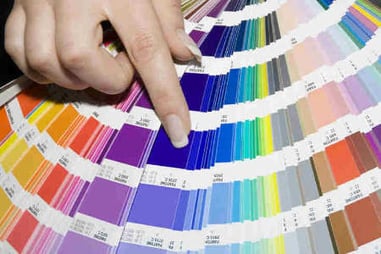What are Pantone Colors?
When people talk about Pantone colors, usually they're referring to the color specified in the Pantone Matching System (PMS). This is a proprietary, standardized color system used across many industries in manufacturing, which describes colors by an allocated number (e.g. “PMS 125”). The Pantone system is the standard language for color communication from designer to manufacturer to retailer to customer. The word “Pantone” comes from the company that invented the system, Pantone Inc. The Pantone system is now largely accepted and relied upon by printers, manufacturers, marketers, artists, designers and others.
How Do Pantone Colors Work?
The Pantone Matching System standardizes 1,114 colors and assigns each color a number and name. By using the Pantone system, people in different locations can refer to the same color by knowing only the number that identifies it. This helps manufacturers and others to avoid mistakes like color deviation between the design and the finished product. As long as a factory has the right Pantone number for the color of your product, they can be sure about whether or not the color will match your specification.
Why are Pantone Colors Important for Inspection?
As a buyer ordering a product from a supplier, you may find the color of an initial “golden sample” looks exactly like what you want. But the units that are mass produced might have a slightly different color that can compromise the whole order. This is why it’s critical to verify color during product inspection.
a slightly different color that can compromise the whole order. This is why it’s critical to verify color during product inspection.
Of course, inspectors can rely on the naked eye to judge less subtle color differences and then take photos to show the client. But for inspections where product specifications are strict on color, it’s important to be precise, either by comparing products to the golden sample for color or to a Pantone color swatch. An inspector can be sure that a product’s color conforms to spec by having a Pantone color swatch and the required Pantone number on-hand during inspection. This is the best way to verify color during a product inspection.
Finally, make sure the Pantone color swatch you’re using is relatively new and was, ideally, purchased within the past year. The inks printed on the color swatch can fade and become yellowish with time. Also, different editions may be printed on different paper stock, e.g. matte finish versus coated finish. This can result in slight color variation between editions.
Conclusion
Pantone colors are derived from the Pantone Matching System, a standardized way to identify specific colors. One major application for Pantone colors is that they help manufacturers to verify that colors match specifications. Professional QC companies rely on Pantone colors during product inspections to make sure their mass produced goods match buyers’ requirements. Pantone color swatches are the best tool available to inspectors for verifying color. If you’re using Pantone colors to identify a color, you should use a fairly new swatch to be sure you’re getting accurate results.






